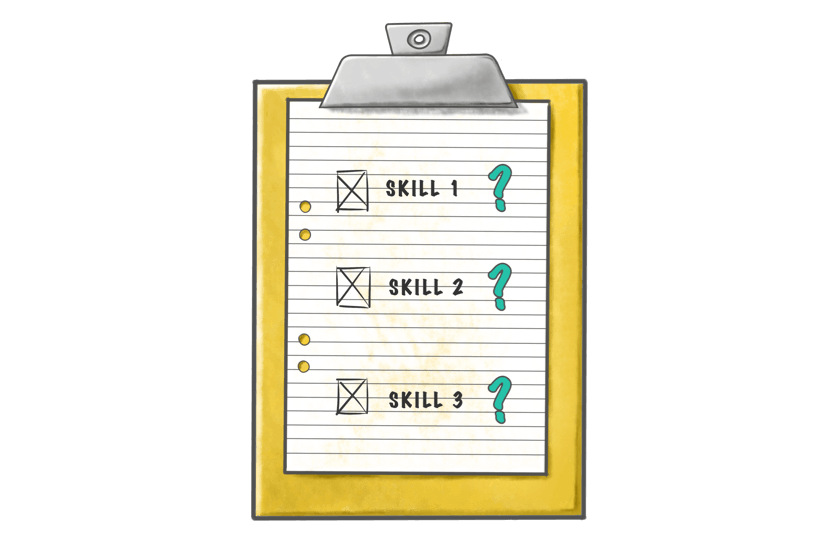
If you're anything like me, you've probably guessed your way through plenty of multiple choice quizzes in your time.
You might have even passed with flying colours (even on that pesky statistics exam that despite the open-book structure, you didn't know which was x and what was y).
However, unlike me, you haven't ended up writing multiple choice questions for a living.
Over the past few years at Yarno, I've learnt a few tricks of the trade and have (almost) perfected the art of the multiple choice quiz.
In the Yarno platform, each quiz question involves three written parts (for now)
- The question (a stem, for you L&D inclined folk)
- 4 answer choices (one correct answer and three incorrect distractors)
- An explanation (to give context and detail to the correct/incorrect answers)
I'll be addressing my tips in roughly that order. So, here we go!
Mistake #1: Grammar is important, people
"Let's eat, grandma", or "Let's eat grandma"
The line between kindness and cannibalism is as fine as the comma that separates them.
And yes, I know, of course grammar is important. But really – a good question, answer or explanation can be ruined by sloppy spelling and grammar.
It's not like a person would set out to make these errors, but sometimes, you can skim over that misplaced comma or spelling mishap after you've been reading over the same questions for weeks.
So how do you avoid them?
Well, luckily, my grammar blunders are often picked up by another member of the content team – it's why we make a point of having several review gates in the content process. Though if you don't have the luxury of a team of other quizmasters, the internet is your friend.
Some handy tools to help you along your way:
Mistake #2: Your questions don't make sense
Again, obvious, but very important.
The person reading the question needs to be able to read the question once and understand what's being asked.
Some tips for clear, simple question writing for you:
Only include information that's relevant to the question (don't clutter!)
Consider the following question:
Last night, you were using a recipe to create a chocolate lava cake for your mother's 50th birthday, as a tribute to her recent worldwide volcano adventure tour. Since her favourite combination is chocolate and orange, you decide to improvise and add some orange to the cake. When you read the instructions for the final step, you realise you've made a mistake earlier in the preparation that required you to consider using one particular ingredient later. What should you do next time?
- Read the whole recipe start to finish first
- Buy double the ingredients in case of mishaps
- Not stray from the exact recipe
- Cook a practice cake first
And compare it to this one:
When using a recipe to cook a dish, what's the most important thing you should do?
- Read the whole recipe from start to finish first
- Buy double the ingredients in case of mishaps
- Not stray from the exact recipe
- Cook a practice dish first
See what I mean?
All of the initial information phrased as a scenario wasn't relevant for the final question in the end. Not the (delicious) chocolate and orange combination, or mum's decision to spend your inheritance visiting the melted rock pimples of the earth.
That's not to say scenarios don't have a place in multiple choice questions (we use them often over here at Yarno), but the information in the scenario has to be useful in answering the question.
Avoid negative phrasing (if you can)
This is a tricky one. It causes a few ruffled feathers in the learning community, but somehow the negatively phrased question still prevails – even if the experts warn against it. Even a seasoned quizmaster like yours truly is guilty of doing it from time to time.
A negatively phrased question is like this:
"Which of the following options does NOT have a negative impact on the quality of a person's sleep?"
A better way to phrase it might be:
"Which of the following options has the a positive impact on the quality of a person's sleep?"
Different question, same answers, but the learning that happens as a result of option 2 would likely be more useful.
Free of unnecessary jargon and acronyms
Are you 100% sure every person doing your quiz will know (by heart) the acronyms you're using in your questions?
If yes, scroll along to the next point.
If no, listen up!
Acronyms and technical jargon that isn't specifically relevant in answering the question just complicates things more than it should (see my point above about clutter).
And if you really have to use them – just spell them out anyway, just to cover your bases.
Written in conversational language
This goes for basically any written content these days.People are people (shock), so why don't we write like we're talking to another person?
Most multiple choice quizzes (in Yarno, at least) aren't testing a person's ability to comprehend A-levels literary construction and a huge vocabulary.
Just ask the thing you'd like the learner to know, and get on with it.
Mistake #3: True or False is not a thing
True or False? True or False questions suck.
Trick question (don't do this). They absolutely suck. There are no two ways about it.
They undermine the power of multi-choice (insulting, I know) because learners are able to reason or guess the correct answer with a pretty decent level of confidence.
If you find yourself wanting to use this type of question, well... do not pass go, and definitely do not collect $200.
Mistake #4: Correct answers shouldn't stick out like a sore thumb
The answers section of a multi-choice question is arguably the most important to get right. If you don't construct the answers correctly, your learners will think you're a joke, and laugh as they choose C again.So, some simple tips here:
- All answers should be about the same length
- All answers should include a similar level of detail
- Answers should be phrased in a similar way
- Incorrect answers should actually be plausible (realistic)
Mistake #5 Explanations are important, so don't be lazy
When a learner answers a question incorrectly, they’re more likely to be receptive to receiving an explanation of what the correct answer was – and why their answer wasn’t correct.
Explanations are where the deeper learning happens, so it’s an important investment of time to write good ones.
A good explanation clearly and succinctly states the correct answer to its question, provides some context for understanding of the question, but nothing more!
It’s crucial that you keep it as short and sharp as possible to avoid losing your learners' attention for that explanation and damaging their respect for the process.
If you feel like you need to write a longer explanation to tick off all the information that needs addressing, consider breaking the explanation down into another question.
To wrap it all up...
Writing a good multiple choice question is like any other skill. It's achievable, and the results are worth it – but it does require some good old fashioned thinking and practice too.
- Write the question like you're asking another human a question
- Make it easy to read with good grammar and formatting
- Write answers that won't trick people
- Take time and care to explain the (correct and incorrect) answers well
- Please, just don't use True/False and Yes/No. It's lazy, folks.
Has this article got you scribbling down quiz questions already? Or do you have a question about how we do it over here at Yarno? Get in touch with me by email or on LinkedIn! I'm always down for a learning chat.
To learn about the big impact little bites of learning can have, download our microlearning white-paper.
















































































































